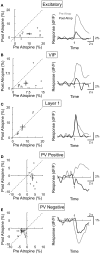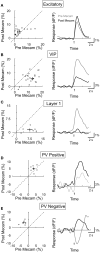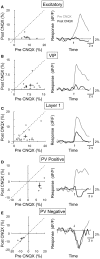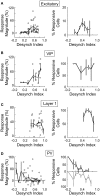Cell-type-specific modulation of neocortical activity by basal forebrain input
- PMID: 23316142
- PMCID: PMC3540901
- DOI: 10.3389/fnsys.2012.00079
Cell-type-specific modulation of neocortical activity by basal forebrain input
Abstract
Activation of the cholinergic neurons in the basal forebrain (BF) desynchronizes cortical activity and enhances sensory processing during arousal and attention. How the cholinergic input modulates the activity of different subtypes of cortical neurons remains unclear. Using in vivo two-photon calcium imaging of neurons in layers 1 and 2/3 of mouse visual cortex, we show that electrical stimulation of the BF bi-directionally modulates the activity of excitatory neurons as well as several subtypes of inhibitory interneurons. While glutamatergic activity contributed to the activation of both excitatory and inhibitory neurons, the contribution of acetylcholine (ACh) was more complex. Excitatory and parvalbumin-positive (PV+) neurons were activated through muscarinic ACh receptors (mAChRs) at low levels of cortical desynchronization and suppressed through nicotinic ACh receptors (nAChRs) when cortical desynchronization was strong. In contrast, vasoactive intestinal peptide-positive (VIP+) and layer 1 interneurons were preferentially activated through nAChRs during strong cortical desynchronization. Thus, cholinergic input from the BF causes a significant shift in the relative activity levels of different subtypes of cortical neurons at increasing levels of cortical desynchronization.
Keywords: acetylcholine; layer 1; parvalbumin; vasoactive intestinal peptide; visual cortex.
Figures










References
Grants and funding
LinkOut - more resources
Full Text Sources
Other Literature Sources
Miscellaneous

